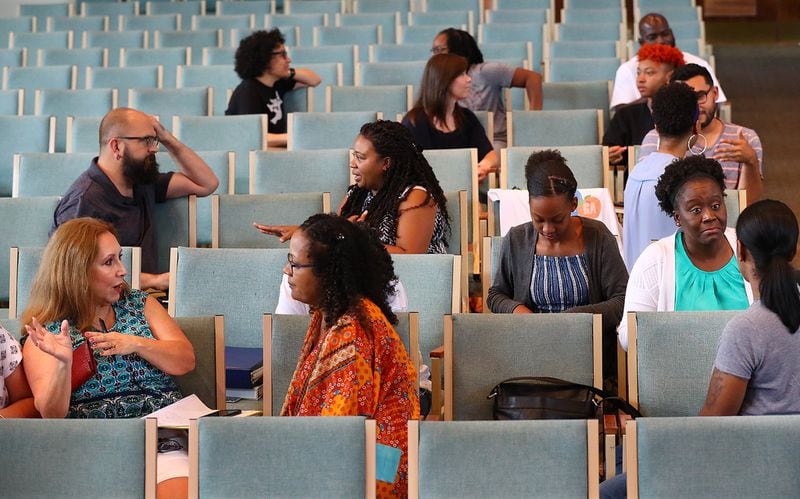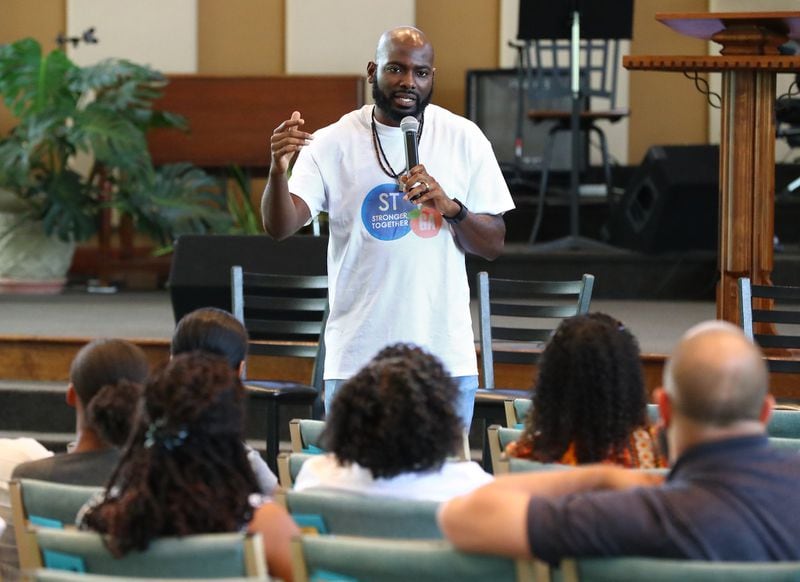In Cobb County schools, the numbers tell a disturbing story, says Mableton Elementary counselor Jennifer Susko.
For months, she and other members of Stronger Together, a small grassroots organization, have been trying to call attention to what they say are problematic disparities in disciplinary rates for white students and their peers of color. At the same time, they point to lopsided white participation in gifted and talented programs, a disproportion that they believe indicates institutional bias against black and Latino students.
But those statistics don’t tell the whole story, the Stronger Together group says. In some cases, they charge, teachers and students have shown racial insensitivity and hostility toward minorities – concerns that school system administrators have refused to even acknowledge.
Though Susko says she and others have tried to talk to school district officials, with few exceptions, they’ve shown an “unwillingness to acknowledge stakeholders’ concerns.”
The stakeholders, in this case, are not just Stronger Together’s core group of about 20 people: 10 students, five parents and the rest school district employees, including Susko and Garrett Middle School counselor John Nwosu. Other stakeholders are the dozens who have gathered with the group to share their own stories of unfair treatment and questionable behavior in the schools.
READ | Racial disparities in school punishment concern black students
Stronger Together wants the district to implement training for teachers and staff on how to identify and correct “implicit bias,” which refers to stereotypes or attitudes that can affect actions unconsciously. Implicit bias can have an effect on how teachers interact with and discipline students, says the group’s co-founder Jillian Ford, a professor of educational equity at Kennesaw State University.
The Cobb County School District is the second largest public school system in the state, behind Gwinnett County. As of March, the district had 111,722 students enrolled. It has 37% of its students identifying as white, 30% as black, 22% as Hispanic, 6% as Asian, 4% as two or more races, and 1% identifying as Pacific Islander or Native American. About 74% of its teachers are white, as are 68% of its principals and 70% of administrators.
Asked by The Atlanta Journal-Constitution to respond to Stronger Together’s concerns, the school system issued a statement, saying, “In the Cobb County School District, we strive to provide every student the opportunity to succeed. We only hire the most qualified candidates at each and every position, and our staff is one of the most diverse in the nation. The diversity of thought, experience and race in our community is one of the reasons Cobb was recently named one of the very best places to work in the United States by Forbes magazine.”
Opinion | The racism Jaylen Brown experienced in Cobb Schools is real
Though Superintendent Chris Ragsdale declined to be interviewed for this story, the system said in a statement that it “wants to know when anyone has a bad experience in one of our schools and we want to hear and listen to how our schools can better serve our community.”
But Ford says the school district is not open to hearing “the reality of what’s going on in the schools.”
“Instead, they are very committed to acting like there is no racism in Cobb County schools,” she says.
Some statistics point to differences in how black students are treated.For instance, while black students made up roughly 30% of the student population of all Cobb County schools in 2015, they accounted for 52% of in-school suspensions, 58% of out-of-school suspensions and 37% of expulsions, Nwosu says, citing stats from the U.S. Department of Education's Office of Civil Rights Data Collection.
In contrast, white students, who made up about 37% of the population, accounted for 21% of in-school suspension, 19% of out-of-school suspensions and 25% of expulsions. Hispanic students, who were about 22% of the population, accounted for 21% of the in-school suspensions, 16% of out-of-school suspensions and 37% of students who were expelled.
Disciplinary cases involving black students were more likely to be referred to law enforcement than white or Hispanic students, data collected by the federal office shows.
RELATED | Cobb officials investigating racist fliers found at Kell High School
Those numbers aren’t too surprising, according to Fred Jones, director of government affairs for the Southern Education Foundation, which began shortly after the end of the Civil War, to provide a public education system for emancipated black people in the South. Across the country, says Jones, black and brown students are expelled at higher rates and are assigned to in-school and out-of-school suspensions more often.
More recent numbers from 2018 compiled by a different organization — the Governor’s Office of Student Achievement — confirmed the same disparity in black student suspensions as the U.S. Department of Education.
The office of student achievement reported Cobb’s in-school suspension rate for black students was 26 percent last year, compared to 19 percent of black students who were suspended across the state. For Cobb’s white students, the in-school suspension rate was 10 percent and 4 percent for out-of-school suspension, which is virtually the same at the state level.
“I would say that’s definitely an issue in Cobb County,” Jones says of the higher in-school suspension rate in Cobb for black students. “It’s something that should be addressed in some way, shape or form.”
While acknowledging that he doesn’t know the nuances of the Cobb system, Jones says school districts in general, “have to do a better job” of supporting students of color, who often come from lower income homes and families.
RELATED | South Cobb schools need more, get less, residents tell board
Nwosu says the achievement gap between races starts early and “only gets wider with time.” When students of color are exposed to negative stereotypes about themselves, they may start believing them.
The additional burden, he believes, leads many to opt out of taking advanced coursed "because they are not expected to be there," he says.
Nwosu also says he’s spoken with students who said they feel teachers speak to them with a level of disdain and that their peers have said outright racist things for “shock value.” The counselor added he isn’t surprised by what he’s been told by students, given the historical context of racism in the United States.
“It’s more disappointing that it’s still happening and we are not in a position to talk openly and honestly about it,” he says.
READ | Cobb school board member takes heat for 'Internet immigration hoax'
Organizers of Stronger Together started meeting with minority school students last summer after hearing some were the target of alleged racist incidents.
In one incident, Ford says, a student told of the hurt she felt when a teacher made light of the Ku Klux Klan. The class was working out a math problem when part of the answer involved the letters K-K-K. The teacher, the student says, “pointed it out and laughed about it.” That student said the alleged encounter made her and other black students feel uncomfortable, “considering the teacher was laughing about a group that lynched, burned, skinned, and terrorized black people.”
In March 2017, a Cobb parent posted on Facebook a screenshot of comments made on SnapChat by a student calling for a return of slavery. That student also mentioned "exterminating all (racial epithet)" and wished that black people never were created. North Cobb High School administrators investigated the incident and sent a letter home to parents denouncing the message.
RELATED | Parents: North Cobb High student who made racist rant, threats shouldn't return
The AJC previously reported that the parent who posted the image said the student who was responsible was suspended for three days, but Cobb school district officials did not comment on the student’s punishment, citing privacy concerns.
“I’m mortified by the fact that students have to endure classmates’ threats [and] teachers’ overt racism,” Ford says.
Stacey Richard says she believes that, when her child was in the first grade, the teacher regularly tagged her child as behaving badly. Richard, whose child is black, says the teacher was more likely to reward white students for their good behavior.
She met with the principal, who never took her seriously, she says. So, she joined Stronger Together.
In its meetings, Stronger Together continues to collect individual accounts of perceived racism. In a follow-up statement to the AJC, the district said,“We are also committed to using data to make decisions. Personal stories are important starting points, but district data tells us the story of all 113,000 students, not a select few. District data tells us that 63% of our students are not white. It also tells us that compared to the national average of 10 percent, 30 percent of Cobb’s 112 principals are an ethnic minority, making Cobb one of the most diverse districts in the nation. Our staff has been trained to treat each student as an individual, and we are proud that our students, staff, and community are among the most welcoming in the nation.”
READ | South Cobb High students protest 'racist' comments
Dr. Jaha Howard, who is in his first term on the Cobb County School Board, says he’s heard Stronger Together’s concerns and will broach the subject with his fellow board members once he gets a better understanding of the issues.
“Right now, I’m in the listening phase,” he says. “I’m trying to get informed and trying to be active with constituents.”
School Board Chairman David Chastain says he had not heard of Stronger Together until recently, but believes students who are battling racism “need to start at their school level” by reporting incidents. He also says the school district is “trying to do its best” in addressing the concerns and meeting the needs of all students.
“The Cobb County School District is very much aware of the diversity of the student population and does everything in its power to make sure everyone is being treated fairly,” Chastain says.
Susko says Cobb school officials can start addressing racism by acknowledging there is a problem.
“I’ve had conversations with a lot of teachers who want to know and want to do better,” she says.
Jones added Cobb County schools and other districts should consider having racial equity training, which would remind educators how the education system was once used to keep black children from receiving an equitable education.
“The community must be involved in terms of addressing inequality, especially racial inequalities in the school systems,” he says.
Nwosu, too, is pushing for professional development for teachers.
“I don’t think people are intentionally racist,” he says. “We do things that contribute to a racist system, but I don’t think most of us make decisions by thinking how they can negatively impact black people and people of color.”
Like Cobb County News Now on Facebook| Follow on Twitter
Stronger Together
Facebook: https://www.facebook.com/strongertogetherga/
Email: strongertogetherga@gmail.com
Instagram: @strongertogetherga
Next meeting: 3-5 p.m. Aug. 25 at Unity North Church, 4255 Sandy Plains Road, Marietta
Cobb County School District numbers at a glance
As of March, the district had 111,722 students enrolled.
37% identify as white
30% black
22% Hispanic
6% Asian
4% identify as two or more races
1% Pacific Islander or Native American
Stronger Together members have concerns about the number of minority students pushed toward academic achievement. In 2015, 63% of elementary and middle school students enrolled in gifted and talented programs were white while 13% were black, 11% were Asian and 7% were Hispanic, according to the Civil Rights Data Collection office. A little more than half of high school students enrolled that year in Advanced Placement/International Baccalaureate Programs were white while less than a quarter were black and roughly 1 in 10 were Asian, with similar representation for Hispanics.
AJC.COM
Rely on AJC.com for the latest updates as students return to school this year.








